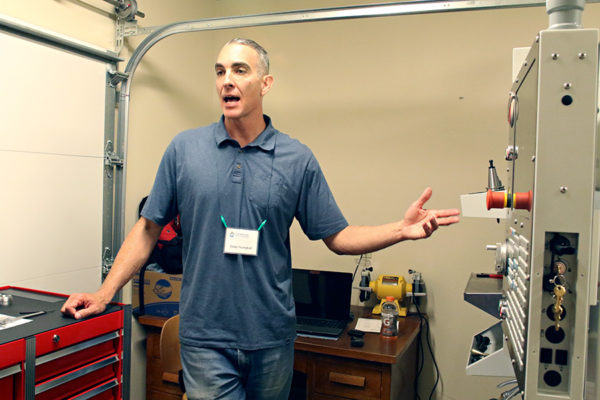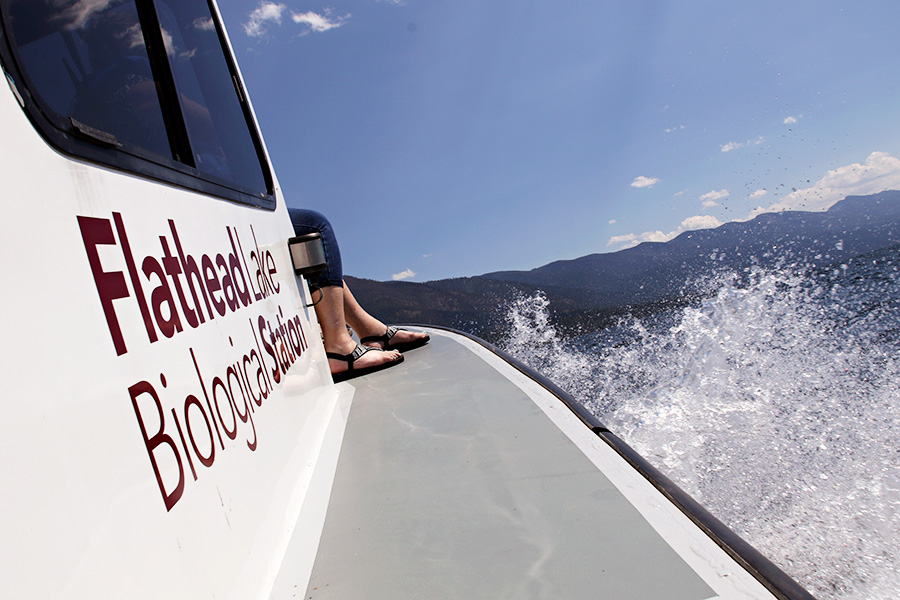Clean, blue and mussel-free.
Calming words during a windy, white-capped day on Yellow Bay, where the Flathead Lake Biological Station recently held its annual open house and delivered a “State of the Lake” report, an annual assessment of the largest freshwater lake west of the Mississippi, whose pristine environment represents an ideal setting for groundbreaking research and a test bed for innovative science.
Just beyond the sheltered inlet on Flathead Lake, miles of teal water unfold, revealing a sprawling watershed that is among the cleanest in the world. Just outside of the enclave, a bright-yellow data buoy bobs into view, an instrument that provides the station’s scientists with daily updates about changing conditions in the lake’s water quality, as well as wind speed and direction, barometric pressure, air temperature, solar radiation, and humidity — clear evidence that Flathead Lake is among the smartest lakes in the country.
All the better to monitor its health and deem it clean, blue and mussel-free.
“The reason that’s so important is because a lot of lakes are not,” Jim Elser, director of the biological station, told members of the public, highlighting a suite of pioneering research projects his faculty of experts are employing to maintain the pristine quality of Flathead Lake. “I hope I’ll be able to say that for the rest of my career here.”
Elser, a renowned freshwater ecologist, replaced Jack Stanford as director in 2016, moving north from the desert landscape of Arizona, where he was a distinguished scientist, scholar and regent’s professor at Arizona State University. He is the station’s seventh director in its 119-year history.

As the oldest biological field station in the western hemisphere, the Flathead institution has served as the “Sentinel of the Lake” since 1899, tracking water quality, influencing sweeping change in local environmental practices and gathering a groundswell of data.
In 1977, it instituted a scientifically rigorous monitoring program that served as the first line of defense against current and future threats to the health and quality of the Flathead watershed. These threats range from aquatic invasive species — like zebra and quagga mussels, first detected in the Missouri River Basin of Montana in 2016 — to nutrient and biological pollution from degraded shoreline septic systems.
Research conducted at FLBS has been an informative force behind significant water-quality conservation achievements, including the ban of phosphorus-containing detergents and the prevention of mining in the upper North Fork Flathead River. The long history of research and monitoring also has resulted in a glut of scientific discovery and insight, cultivating one of the most robust ecological and water-quality records in the world.
“We have a lot to be proud of here,” Elser said.
Chief among those points of pride is the recent work by Cody Youngbull, a physicist and entrepreneur with a Ph.D. in condensed matter physics, who joined the bio station to develop a new facility on the campus that builds state-of-the-art sensors and robotics used in water environments, called SensorSpace. These sensors will be able to detect past and present signs of life in the depth of the lake, or study DNA in the water, among other possibilities.

The new facility was on full display at the station’s Aug. 3 open house, and includes high-tech manufacturing and robotic equipment, including 3D printers, as well as laser-cutting systems. The facility is available to all stripes of researchers and entrepreneurs working to create innovative sensor technology, Youngbull said.
Located on the biological station’s campus, SensorSpace is available to anyone interested in small-scale production and development.
“I am my own customer,” Youngbull said, referring to the tools he manufactures at the station. “But we can manufacture almost anything for almost anyone.”
The environmental sensors he invented are able to provide real-time DNA detection of invasive species such as quagga or zebra mussels using eDNA (or environmental DNA) techniques pioneered by Bio Station Research Professor Gordon Luikart, a world leader in emerging eDNA technology, a revolutionary system that can detect the presence of targeted invasive species more quickly and efficiently than conventional measures.
Its application as an early-warning, onsite detection system is unprecedented. In a sprawling body of water like Flathead Lake, relying on visual assessments to search for invasive mussels is like looking for a needle in a haystack.
With Youngbull’s technology — called Digital Droplet PCR — all it takes is one biological cell.
“The response time, the lag in understanding, the whole wait-and-see approach is dramatically reduced and more effective,” Youngbull said. “Instead of waiting weeks, we know the results in real time.”
Along with Elser and research scientist Zane Lindstrom, Youngbull recently proved the sensors can perform in real-world scenarios when the scientists traveled to the Lake Mead Recreation Area in southern Nevada to conduct field tests on the “DNA Tracker.”

Invasive quagga mussels were first discovered in Lake Mead in 2007, and they have since enjoyed unfettered growth, overwhelming hydropower infrastructure like Hoover Dam and spreading to downstream systems in Mohave and Havasu lakes. The devastation in Lake Mead is a specter of the havoc that a mussel infestation could cause in the Flathead, but it also serves as a prime location for the researchers to test the tracker.
After first testing the DNA Tracker (the delicate equipment is contained inside an orange, briefcase-sized box) on mussel larvae they collected using plankton nets, the researchers were stumped when the box didn’t return any positive hits. With flagging spirits, the team returned the next day to try a new approach — they would pass filtered water samples directly through the tracker.
Within an hour, they had positive results.
Spirits buoyed, the researchers enjoyed the same success at numerous sites on Lake Mead, and also tested the tracker at a boat access, collecting water samples from a boat that had just emerged from the water and again returning a positive hit. After the boat underwent the mandatory decontamination process, they tested again for mussels.
The results were negative.
“It’s the world’s first onsite validation of contamination and it offers real-time results,” Youngbull said. “The meta message out there right now is that mussel infestation in Flathead Lake is fait accompli. I don’t feel that way. For us, it’s not a matter of if but when. We can keep them out.”
Despite the failure of the research team’s initial efforts, Youngbull said the serendipitous discovery was invaluable.
Using fresh water samples from the lake, Youngbull said the positive hits were coming from something called free eDNA, or dying cells entering a phase of decay called lysis. Free eDNA is generally disregarded in the research community because it degrades quickly as it’s broken down by UV light and bacteria, but for Youngbull’s purposes — testing a sample onsite in real time — it is ideal.
“What we lose in time due to its rate of degradation we gain in sensitivity,” he said. “We built a machine that is designed to be used onsite, and here’s a sample that can only be tested onsite. It’s a game-changer.”
By the end of August, a DNA tracker will be installed at the watercraft inspection station in Ravalli on Montana Highway 200, where bio station staff will monitor boats passing through, improving the chances of intercepting a mussel-fouled boat, as well as building confidence that the decontamination process is effective.
While the DNA Tracker operates as a semi-autonomous machine, Youngbull has also developed DNA “smoke alarms,” designed to function autonomously at unmanned monitoring stations, with a range of potential applications, including checking for food-borne illnesses like E. coli or detecting respiratory diseases in livestock troughs.
For the bio station team, it’s another step toward fortifying the defense mechanisms of Flathead Lake to stave off invasive mussels and, if contamination should occur, detecting it early on, when there’s still a chance to fight back.
“If I could write my own checks, there would be a DNA Tracker at every marina and boat access on Flathead Lake,” Elser said. “We are able to show and demonstrate the effectiveness of the decontamination at the various stations without slowing people down. It’s very exciting.”
The DNA Tracker’s new findings figured prominently into discussion at the open house, but the event also featured a diverse roster of research projects carried out by a faculty of 40 year-round staff, a host of interns and fellows, and a robust summer program of more than 60 students representing 26 institutions, from 23 states and three countries.
“It really is experiential learning at its finest,” Elser said of the program.

According to research conducted in 2014 by the University of Montana, Flathead Lake’s pristine identity had an estimated $6-8 billion impact on shoreline property values and is worth roughly $1.6 billion in “nature-based tourism” in Flathead and Lake counties.
The bio station is also building out its K-12 education program, with about 1,400 students participating in the Flathead Lake Aquatic Research and Education program last school year, both through field trips and classroom presentations, according to Monica Elser, the station’s education liaison.
The program’s growth was made possible due to a $500,000 donation by Gretchen and Edward Heffernan, which allowed the station to buy new equipment and develop curriculum.
For more information, or to donate to the Flathead Lake Biological Station, call (406) 982-3301 or visit https://flbs.umt.edu/.
